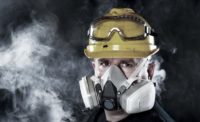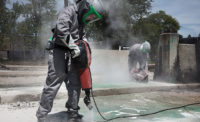OSHA respirable crystalline silica – general industry

History
During the 1930s, hundreds of workers who’d inhaled respirable crystalline silica (RCS) while toiling on a tunnel construction project in West Virginia died from silicosis, an incurable lung disease. The shocking wave of deaths caused U.S. Labor Secretary Frances Perkins to launch a national campaign aimed at preventing silicosis, the oldest known environmental lung disease. In March, 2016, OSHA issued a final rule to protect workers exposed to RCS in general industry and maritime. The agency will begin enforcing most provisions of the standard on June 23, 2018.
Case study
Steve Willis of Asheville, North Carolina, began working as a sandblaster when he was 22 years old. On the job, Steve used specialized equipment to blast surfaces with silica sand, a mineral abrasive, in order to smooth them, shape them or remove contaminants. The procedure created large quantities of dust, to which he was regularly exposed. In his late 40s, Steve noticed that he was often short of breath. Weight dropped from his already-lean frame and he experienced fatigue that no amount of rest could alleviate. After a chest X-ray and a CT scan, Steve was diagnosed with acute silicosis, a devastating disease that has left his lungs permanently scarred. His life expectancy is less than five years.
Key compliance requirements
- Exposure limits must meet the PEL of 50 micrograms of RCS per cubic meter of air (μg/m3) averaged over an 8-hour day (8-hr TWA).
- Engineering and work practice controls should be used to reduce and maintain employee exposure to RCS to or below the PEL.
- When those measures aren’t sufficient, workers must be provided with personal protective equipment.
- The employer must establish and implement a written exposure control plan.
Why this standard is important
Approximately 2.3 million workers are exposed to RCP in their workplaces, which puts them at increased risk of developing silicosis, lung cancer, chronic obstructive pulmonary disease (COPD) and kidney disease.
RCP is created when cutting, sawing, grinding, drilling, and crushing stone, rock, concrete, brick, block, and mortar. Workers at greatest risk are those who move or blast rock and sand (miners, quarry workers, stonecutters) or who use silica-containing rock or sand abrasives (sand blasters; glass makers; foundry, gemstone, and ceramic workers; potters). Fracking operations are also a source of RCP. Coal miners are at risk of mixed silicosis and coal workers’ pneumoconiosis.
Enforcement Statistics
There are no enforcement statistics available for this standard yet.
Industries that may be cited:
- Coal mining
- Quarries
- Stonecutting
- Foundries
- Glassmakers
- Fracking
Compliance assistance resources
- OSHA Safety and Health Topics: Silica
- OSHA “Crystalline Silica Exposure” - Health Hazard Information for General Industry Employees
- OSHA Small Entity Compliance Guide for the Respirable Crystalline Silica Standard for General Industry and Maritime
Looking for a reprint of this article?
From high-res PDFs to custom plaques, order your copy today!





